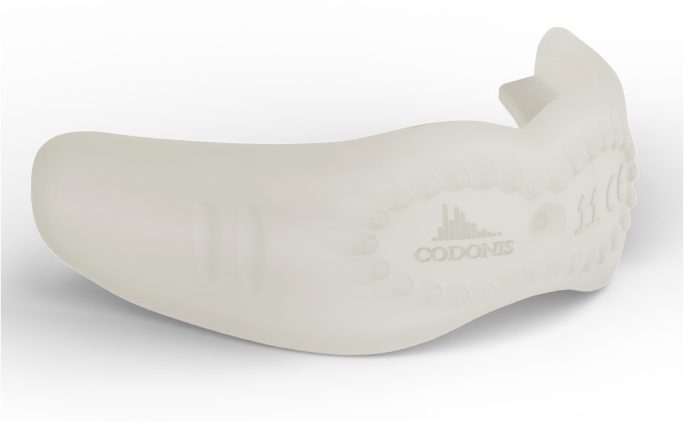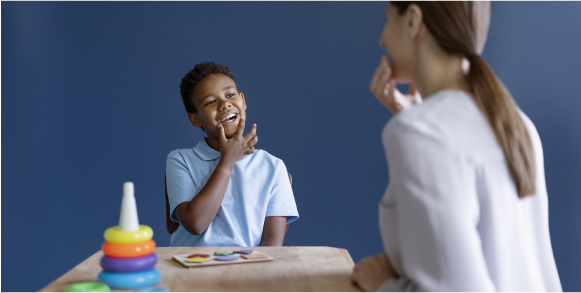Optimale Therapie für eine verbesserte Patientenversorgung und bessere Ergebnisse

Optimale Therapie für eine verbesserte Patientenversorgung und bessere Ergebnisse

Einzigartiges Oberflächendesign
Der CODONIS LWZ hat eine einzigartige Oberfläche - die Vorderseite hat ein spezielles Design zur Stimulierung von angrenzenden Muskelstrukturen mittels oberflächlicher Noppen.
Für alle
Die CODONIS LWZ ist in einzigartiger Weise für Kinder im Milchgebiss bis hin zu Senioren konzipiert
Positionierung
Um den CODONIS LWZ in Position zu halten, ist das Gerät mit Aufbiss-Hilfen ausgestattet.
CODONIS App
Eine einzigartige Plattform zur Personalisierung des CODONIS LWZ mit individuellem Therapieplan

Der CODONIS LWZ hat eine einzigartige Oberfläche - die Vorderseite hat ein spezielles Design zur Stimulierung von angrenzenden Muskelstrukturen mittels oberflächlicher Noppen.
Die CODONIS LWZ ist in einzigartiger Weise für Kinder im Milchgebiss bis hin zu Senioren konzipiert
Um den CODONIS LWZ in Position zu halten, ist das Gerät mit Aufbiss-Hilfen ausgestattet.
Eine einzigartige Plattform zur Personalisierung des CODONIS LWZ mit individuellem Therapieplan
In der Adaptierungsphase wird die Anwendung des Geräts kontinuierlich gesteigert.
In der Intensiv-Phase fördern die Therapeuten den Patienten auf , den CODONIS LWZ über ein längeres Therapieintervall zu verwenden.
In der Fade-Out-Phase wird die Therapiedauer kontinuierlich reduziert.
Zur Sicherstellung des Erfolges sollten Nachkontrollen, bevorzugt nach 1, 3 und 6 Monaten nach Verwendung des CODONIS LZW, durchgeführt werden.
Einfach – in wenigen Schritten ist der CODONIS LWZ auf dem Weg zu Ihnen


Ahmad, M. and Schiffman, E.L. (2016) ‘Temporomandibular Joint Disorders and Orofacial Pain’, Dental clinics of North America, 60(1), pp. 105–124. Available at: https://doi.org/10.1016/j.cden.2015.08.004
D’Onofrio, L. (2019) ‘Oral dysfunction as a cause of malocclusion’, Orthodontics & Craniofacial Research, 22 Suppl 1(Suppl 1), pp. 43–48. Available at: https://doi.org/10.1111/ocr.12277
Grabowski, R., Kundt, G. and Stahl, F. (2007) ‘Interrelation between occlusal findings and orofacial myofunctional status in primary and mixed dentition: Part III: Interrelation between malocclusions and orofacial dysfunctions’, Journal of Orofacial Orthopedics = Fortschritte Der Kieferorthopadie: Organ/Official Journal Deutsche Gesellschaft Fur Kieferorthopadie, 68(6), pp. 462–476. Available at: https://doi.org/10.1007/s00056-007-0717-y
Huber, Bettina (2017) Wirkungsweise des Lippen-Wangen-Zungen-Trainers (LWZ-Trainers) auf das infantile Schluckmuster (Pilotstudie). Master Thesis. Klinik für Mund -, Kiefer- und Gesichtschirurgie Universitätsspital Basel.
Koka, V. et al. (2021) ‘Orofacial Myofunctional Therapy in Obstructive Sleep Apnea Syndrome: A Pathophysiological Perspective’, Medicina, 57(4), p. 323. Available at: https://doi.org/10.3390/medicina57040323
Pizolato, R.A., Freitas-Fernandes, F.S. de and Gavião, M.B.D. (2013) ‘Anxiety/depression and orofacial myofacial disorders as factors associated with TMD in children’, Brazilian Oral Research, 27(2), pp. 156–162. Available at: https://doi.org/10.1590/s1806-83242013000100021
Ray, J. (2006) ‘Orofacial myofunctional deficits in elderly individuals’, The International Journal of Orofacial Myology: Official Publication of the International Association of Orofacial Myology, 32, pp. 22–31.
Seemann, J., Kundt, G. and Stahl de Castrillon, F. (2011) ‘Relationship between occlusal findings and orofacial myofunctional status in primary and mixed dentition: part IV: interrelation between space conditions and orofacial dysfunctions’, Journal of Orofacial Orthopedics = Fortschritte Der Kieferorthopadie: Organ/Official Journal Deutsche Gesellschaft Fur Kieferorthopadie, 72(1), pp. 21–32. Available at: https://doi.org/10.1007/s00056-010-0004-1
Streff, Susanne (2017) Evaluation der Wirkweise des Lippen-Wangen-Zungen-Trainers auf die orofaziale Muskulatureine prospektive Pilotstudie bei Erwachsenen aus logopädischer Sicht. Master Thesis. Klinik für Mund-, Kiefer- und Gesichtschirurgie Universitätsspital Basel.
Sude, A. et al. (2021) ‘Temporomandibular Disorder Related Characteristics and Treatment Outcomes in Oromandibular Dystonia Patients in Two Different Clinical Settings: A Cross-Sectional Study’, Journal of oral rehabilitation, 48(5), pp. 542–550. Available at: https://doi.org/10.1111/joor.13162
Wir empfehlen, den CODONIS LWZ für einen Standardzyklus von etwa 3 Monaten zu verwenden. Nach dieser Zeit sollte der CODONIS LWZ ausgetauscht werden
Der CODONIS LWZ kann überall dort verwendet werden, wo sich der Patient aufhält. Der Patient sollte aus hygienischen Gründen darauf achten, dass er sich vor der Verwendung des Geräts die Hände reinigt
Ja, das kann man.
Dies hängt vom Patienten und seiner Fähigkeit ab, den CODONIS LWZ zu benutzen. Es kann ratsam sein, Kinder oder beeinträchtigte Personen zuerst mit dem Gerät vertraut zu machen und dann – nach einem Routineplan – die Therapie durchzuführen.
CODONIS is a Swiss based company which develops and markets innovative and forward-looking medical products for logopedics, myofunctional therapy and dentistry.
Office:
Tramstrasse 99, 4132 Muttenz, Switzerland
Email:
contact@codonis.ch
VAT: CHE-316.119.424
Ahmad, M. and Schiffman, E.L. (2016) ‘Temporomandibular Joint Disorders and Orofacial Pain’, Dental clinics of North America, 60(1), pp. 105–124. Available at: https://doi.org/10.1016/j.
D’Onofrio, L. (2019) ‘Oral dysfunction as a cause of malocclusion’, Orthodontics & Craniofacial Research, 22 Suppl 1(Suppl 1), pp. 43–48. Available at: https://doi.org/10.1111/ocr.
Grabowski, R., Kundt, G. and Stahl, F. (2007) ‘Interrelation between occlusal findings and orofacial myofunctional status in primary and mixed dentition: Part III: Interrelation between malocclusions and orofacial dysfunctions’, Journal of Orofacial Orthopedics = Fortschritte Der Kieferorthopadie: Organ/Official Journal Deutsche Gesellschaft Fur Kieferorthopadie, 68(6), pp. 462–476. Available at: https://doi.org/10.1007/
Huber, Bettina (2017) Wirkungsweise des Lippen-Wangen-Zungen-Trainers (LWZ-Trainers) auf das infantile Schluckmuster (Pilotstudie). Master Thesis. Klinik für Mund -, Kiefer- und Gesichtschirurgie Universitätsspital Basel
Koka, V. et al. (2021) ‘Orofacial Myofunctional Therapy in Obstructive Sleep Apnea Syndrome: A Pathophysiological Perspective’, Medicina, 57(4), p. 323. Available at: https://doi.org/10.3390/
Pizolato, R.A., Freitas-Fernandes, F.S. de and Gavião, M.B.D. (2013) ‘Anxiety/depression and orofacial myofacial disorders as factors associated with TMD in children’, Brazilian Oral Research, 27(2), pp. 156–162. Available at: https://doi.org/10.1590/s1806-
Ray, J. (2006) ‘Orofacial myofunctional deficits in elderly individuals’, The International Journal of Orofacial Myology: Official Publication of the International Association of Orofacial Myology, 32, pp. 22–31.
Seemann, J., Kundt, G. and Stahl de Castrillon, F. (2011) ‘Relationship between occlusal findings and orofacial myofunctional status in primary and mixed dentition: part IV: interrelation between space conditions and orofacial dysfunctions’, Journal of Orofacial Orthopedics = Fortschritte Der Kieferorthopadie: Organ/Official Journal Deutsche Gesellschaft Fur Kieferorthopadie, 72(1), pp. 21–32. Available at: https://doi.org/10.1007/
Streff, Susanne (2017) Evaluation der Wirkweise des Lippen-Wangen-Zungen-Trainers auf die orofaziale Muskulatureine prospektive Pilotstudie bei Erwachsenen aus logopädischer Sicht. Master Thesis. Klinik für Mund-, Kiefer- und Gesichtschirurgie Universitätsspital Basel.
Sude, A. et al. (2021) ‘Temporomandibular Disorder Related Characteristics and Treatment Outcomes in Oromandibular Dystonia Patients in Two Different Clinical Settings: A Cross-Sectional Study’, Journal of oral rehabilitation, 48(5), pp. 542–550. Available at: https://doi.org/10.1111/joor.
Reservieren Sie sich Ihren Platz für unser Online-Training!